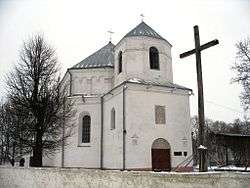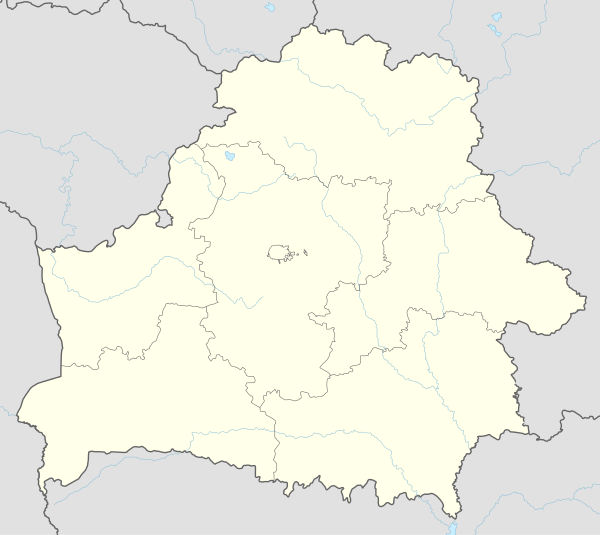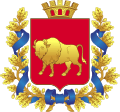Smarhonʹ
Smarhonʹ or Smorgonʹ (Belarusian: Смарго́нь, [smarˈɣonʲ]; Russian: Сморгонь; Lithuanian: Smurgainys; Polish: Smorgonie; Yiddish: סמאָרגאָן) is a city in the Grodno Region of Belarus. It was the site of Smarhonʹ air base, now mostly abandoned. Smarhoń is located 107 km from the capital, Minsk.
Smarhoń Смаргонь (in Belarusian) | |
|---|---|
 Church of Saint Michael | |
 Flag  Coat of arms | |
 Smarhoń | |
| Coordinates: 54°29′1″N 26°24′0″E | |
| Country | |
| Region | Hrodna Region |
| Founded | October 2, 1503 |
| Elevation | 150 m (490 ft) |
| Population (2009)[1] | |
| • Total | 36,283 |
| Time zone | UTC+2 (EET) |
| • Summer (DST) | UTC+3 (EEST) |
| Postal code | 231000, 231041-231045 |
| Area code(s) | +375 1592 |
| License plate | 4 |
| Website | Official website |
History
Within the Grand Duchy of Lithuania, Smarhonʹ was part of Vilnius Voivodeship. In 1795, the town was acquired by the Russian Empire in the course of the Third Partition of Poland. Until the mid 19th century, Smarhonʹ was a private property of the Radziwiłł family with most of its population being Jewish.
From 1921 until 1939, Smarhonʹ (Smorgonie) was part of the Second Polish Republic. In September 1939, the town was occupied by the Red Army and, on 14 November 1939, incorporated into the Byelorussian SSR.
From 25 June 1941 until 4 July 1944, Smarhonʹ was occupied by Nazi Germany and administered as a part of the Generalbezirk Litauen of Reichskommissariat Ostland.
Smorgonʹ is known as the place where a school of bear training, the so-called "Bear Academy", was founded.
Smarhonʹ baranki
Up until World War II, Smarhonʹ was widely known for its baranki,[2] traditional Eastern European ring-shaped bread rolls, similar to bagels and bubliki. Russian food historian William Pokhlyobkin considered Smarhonʹ to be the brithplace of baranki.[3] Baranki were supposedly used to feed bears in the Bear Academy. Written accounts of Smarhonʹ baranki appeared in the 19th century. Polish-Lithuanian journalist Adam Kirkor wrote in the encyclopedia Picturesque Russia: "In Smorgonʹ, Oshmyany district, Vilna province, almost all the petty bourgeois population is busy baking small bubliki, or kringles, which are widely known as Smorgonʹ obvaranki. Each traveller would definitely buy several bundles of these bubliki; besides, they are transported to Vilna and other cities."[4] Władysław Syrokomla mentioned Smarhonʹ as "the capital of obwarzanki famous in all Lithuania".[5] Smarhonʹ obwarzanki were a traditional treat at Saint Casimir's Fair in Vilnius.[6][7]
Twin towns – sister cities
Smarhonʹ is twinned with:



Famous natives and citizens of Smarhonʹ
- Peter Blume (1906–1992) US painter, in magic realism style
- Isaac Itkind (1871-1969) - distinguished Russian and Soviet sculptor
- Abraham Isaac Kook (1865-1935) rabbi, Jewish theologist, Ashkenazi chief rabbi of Palestine, learned in Smarhonʹ Yeshiva
- Moyshe Kulbak (1896–1937) Belarusian Yiddish poet, writer, executed by the NKVD
- Moshe Kussevitzki (1899–1966) Polish-US Jewish cantor
- Ida Lazarovich Gilman or Ida Mett (1901–1973) Russian anarchist militant and author, exiled in France
- Shalom Levin (1916-1995) Secretary Gen. and President of Israel Teachers Union, Knesset (Parliament) Member, educator and author.
- Karol Dominik Przezdziecki (1782–1832) Polish count, fighter for the liberation of Poland in the revolt of 1830–1831
- David Raziel (1910–1941) fighter for the emancipation of Jews in Palestine, commander of the Irgun Tzvai Leumi nationalist resistance organization, killed in Iraq on an anti-Nazi mission
- Esther Raziel Naor (1911–2002) Israeli politician, militant in the Irgun Jewish nationalist resistance during the British mandate in Palestine
- William Schwartz (1896–1977) US painter
- Abraham Sutzkever (1913–2010) a Yiddish and Polish poet and Second World War partisan
- The Gordin brothers, Abba (1887–1964) and Wolf, anarchist educators, militants, and theorists
- Ida Mett (1901-1973), anarchist writer[8]
References and notes
- "World Gazetteer". Archived from the original on 2013-01-11.
- Russian: баранки, Belarusian: обваранки, romanized: obvaranki, Polish: obwarzanki
- Баранки. In: В. В. Похлёбкин, Кулинарный словарь от А до Я. Москва, Центрполиграф, 2000, ISBN 5-227-00460-9 (William Pokhlyobkin, Culinary Dictionary. Moscow, Centrpoligraf publishing house, 2000; Russian)
- Адам Киркор (1881). Живописная Россия. 1. p. 217. (Adam Kirkor (1881). Picturesque Russia (in Russian). 1. p. 217.)
- Уладзіслаў Сыракомля (1993). "З дарожнага дзённіка 1856 года". Добрыя весці: паэзія, проза, крытыка (in Belarusian). Маст. літ. pp. 425–433.
- Францішак Багушэвіч (1998). "Публіцыстыка, 1885". Творы (PDF). Мінск. (Francišak Bahuševič (1998). "Journal publications, 1885". Writings (in Belarusian). Minsk.)
- Alfons Wysocki (1937-02-28). "Na Kaziuku" (PDF). AS, Tygodnik Ilustrowany (in Polish).
- Heath, Nick (2006). "Mett, Ida, 1901-1973". Libcom.
External links
| Wikimedia Commons has media related to Smarhoń. |
